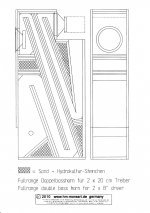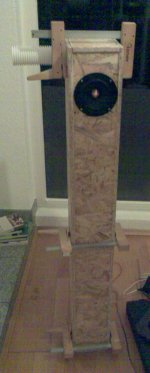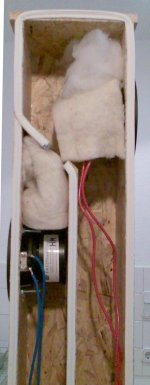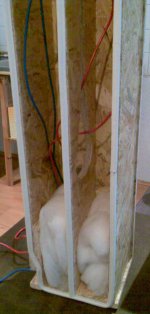Hi,
are both horns with their drivers optimized to balance their
impedances in a way to be a more resistive load than a single
one would be ?
An impedance plot of either of the single drivers and both connected
in parallel would be interesting to see in how far the motional
parts of the driver impedances are balancing.
The folding looks nice indeed.
Kind Regards
are both horns with their drivers optimized to balance their
impedances in a way to be a more resistive load than a single
one would be ?
An impedance plot of either of the single drivers and both connected
in parallel would be interesting to see in how far the motional
parts of the driver impedances are balancing.
The folding looks nice indeed.
Kind Regards
Imp
Hello,
yes,
look my KORNETT real
measurements and simulations:
kornettmess
all double horns look nearly the same.
Hello,
yes,
look my KORNETT real
measurements and simulations:
kornettmess
all double horns look nearly the same.
A question:
Have you experimented with a resistive vent
connecting the throats of both horns behind
the driver chamber ?
Would it make sense ?
Pictures are an offspin i made from a cabinet called
"SIKLONE" from Graham Maynard.
That kind of enclosure could be tuned to exhibit
a very similar impedance plot like the free air
impedance of both drivers in parallel and had a
very well balanced bass performance. Not comparable
to your horns due to efficiency of course.
Kind Regards
Have you experimented with a resistive vent
connecting the throats of both horns behind
the driver chamber ?
Would it make sense ?
Pictures are an offspin i made from a cabinet called
"SIKLONE" from Graham Maynard.
That kind of enclosure could be tuned to exhibit
a very similar impedance plot like the free air
impedance of both drivers in parallel and had a
very well balanced bass performance. Not comparable
to your horns due to efficiency of course.
Kind Regards
Attachments
Last edited:
Hello,
Marc,
look here, it is Manger:
basstuba
basstubamess
i tested also Tannoy 6,5 and Dynaudio 17W75 (pic at bottom)
oliver,
"Have you experimented with a resistive vent
connecting the throats of both horns behind
the driver chamber ?
Would it make sense ?"
i don´t think so because the effect
of coupling to different acoustic horns
electrically parallel will disturb.
Marc,
look here, it is Manger:
basstuba
basstubamess
i tested also Tannoy 6,5 and Dynaudio 17W75 (pic at bottom)
oliver,
"Have you experimented with a resistive vent
connecting the throats of both horns behind
the driver chamber ?
Would it make sense ?"
i don´t think so because the effect
of coupling to different acoustic horns
electrically parallel will disturb.
Hi rjbond3rd
look the Kornett simulation (last one),
i construct it with a view on the membran movement.
Most double horns are 1,4-1,7 m and 2,55 m.
IVO wrote:
"the rear driver can be a woofer or a second fullrange driver. -- The two drivers drive two different horns, of different length and expansion.
The idea is that the horns have different peaks and dips and fill in each other's weak points.
look the Kornett simulation (last one),
i construct it with a view on the membran movement.
Most double horns are 1,4-1,7 m and 2,55 m.
IVO wrote:
"the rear driver can be a woofer or a second fullrange driver. -- The two drivers drive two different horns, of different length and expansion.
The idea is that the horns have different peaks and dips and fill in each other's weak points.
Hello,
i don´t think so, a TH would create colorations,
because it is fullrange.
This is a tapped horn solution, the Subfanfare
subfanfare
but only up to 100 Hz, even though
you can use the bass horn up to 250 Hz,
but in the TH case it does not sound.
i don´t think so, a TH would create colorations,
because it is fullrange.
This is a tapped horn solution, the Subfanfare
subfanfare
but only up to 100 Hz, even though
you can use the bass horn up to 250 Hz,
but in the TH case it does not sound.
Hi,
polyester Watte around the driver,
not in the horn throat,
the softfiber reduce inner reflections
over 100 Hz.
I will also try softfibers at some places, nice idea.
Kind Regards
Hello,
a double horn works if the horns are electrical parallel,
by bi amping you don´t get it.
look the RDH20 imp with zobel filter, 2 measurement,
rdhmess
and below 50 Hz, every amp will love it, no bass imp flat 4 =Ohm, no watts needed,
low level of membran movement etc.
evident listenable
a double horn works if the horns are electrical parallel,
by bi amping you don´t get it.
look the RDH20 imp with zobel filter, 2 measurement,
rdhmess
and below 50 Hz, every amp will love it, no bass imp flat 4 =Ohm, no watts needed,
low level of membran movement etc.
evident listenable
- Status
- This old topic is closed. If you want to reopen this topic, contact a moderator using the "Report Post" button.
- Home
- Loudspeakers
- Full Range
- fullrange double horn



